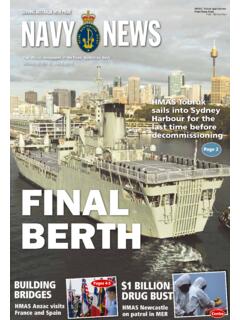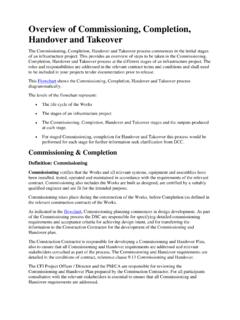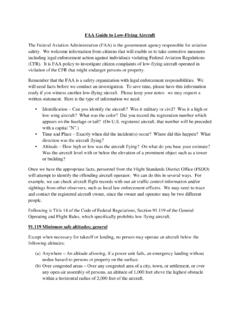Transcription of 7. Aircraft Hazards and Risks - Department of Defence
1 198 7. Aircraft Hazards and Risks This chapter investigates the Hazards and potential Risks of planned Super Hornet flying operations at RAAF Base Amberley. Assessment and analysis of Super Hornet flying operations and associated Aircraft accident Risks , including potential bird strike Hazards and Aircraft accident Risks in the vicinity of RAAF Base Amberley, were conducted. The chapter includes a review and assessment of command and control procedure adequacy and provides recommendations regarding current and planned mitigation measures of each summarized risk. Details regarding the aviation hazard and risk assessment are provided in the Technical Report Aviation Hazard and Risk attached as Appendix K. Methodology The risk assessment methodology was based on the risk analysis model of AS/NZS 4360:2004 Risk Management. The AS/NZS 4360:2004 Risk Management is an industry Standard and the general principles outlined in the guideline comprise the following steps: Establish the context with relevance to aviation risk; Identify the Risks ; Analyse Risks , in terms of consequences and likelihood; Evaluate the Risks by comparison with predetermined criteria; and Prepare and implement a risk treatment plan.
2 The risk assessment and analysis was based on both current and planned operations as well as existing and planned airfield conditions. Due to the complexities associated with evaluating operations and conditions, the assessment and analysis are generally more qualitative than quantitative. Existing conditions and current or historical data provide information more supportive of quantitative results. The effect of flight paths and frequency of Aircraft movements were analysed as potential contributors to the risk of accidents involving residential and industrial areas. Aircraft Risk Assessment A probability analysis of military Aircraft accidents within Australia and Super Hornet worldwide provided a baseline for determining potential impacts associated with Super Hornet flying operations at RAAF Base Amberley. The following potential impacts were evaluated and to the extent practicable are presented in a quantitative manner.
3 199 These include the consequences of Aircraft accidents: Occurring on RAAF Base Amberley; Occurring in adjacent residential areas; Occurring in adjacent industrial areas; Involving other Aircraft ; Into or over water catchments or reservoirs; Involving fuel spills or igniting bushfires; and All other known potential Risks . Consideration of the phase of flight and location relative to RAAF Base Amberley assisted in the estimation of Aircraft accident probability in comparison with the frequency of operations. Land use management strategies and consequences were given consideration in the estimation. Bird Strike Analysis A site visit to RAAF Base Amberley was undertaken to identify sites on or near the airport that attract birds or bats and the routes of flight used including any seasonal variations. The relative risk of bird strikes was determined with a semi-quantitative and qualitative discussion of the following points: The difference in risk between present and proposed flying operations; The anticipated magnitude of the risk under proposed flying operations; Bird strike risk management with regard for current and proposed procedures; Projected success of planned mitigation measures; and The expected consequences of each level of risk.
4 Hazards and Risks to People and Property Potential Hazards and Risks to people and property were investigated for future Super Hornet operations at RAAF Base Amberley and included: Death or personal injury resulting from Aircraft accidents and incidents; Damage to or total loss of Aircraft ; Damage to buildings and structures; and Damage to or total loss of vehicles. 200 Hazards and Risks to Waterways, Livestock, Flora and Fauna Potential Hazards and Risks to environmental values were investigated for future Super Hornet operations at RAAF Base Amberley and included: Contamination of nearby waterways by fuel or hazardous materials; Death or injury to livestock as a result of Aircraft accidents or incidents; Damage to flora caused by fuel spillage, fire or hazardous materials; and Injury or death to fauna ( birds and animals) as a result of Aircraft accidents or incidents including those caused by animal or bird strikes.
5 Command and Control Procedures A high level review of emergency response procedures provided the basis for a discussion of the following additional Aircraft hazard and risk issues: Fire safety controls, including bushfire ignition, and hazardous materials spill response; A description of relationships with disaster control organisations including command and control; and Measures to reduce the risk of hazardous incidents affecting the public and environment. Review of Existing Data Accident Risk Assessment An extensive review of literature and data was conducted for the Aircraft accident assessment regarding aviation Risks , accident data, the Super Hornet operational data and policies and procedures relating to Aircraft operations and risk mitigation. Aircraft accident data from Defence is provided in Appendix K. Bird Strike Analysis The bird strike analysis and associated risk of bird and bat strikes at RAAF Base Amberley was conducted through an extensive review of literature and data.
6 Data on reported bird strikes occurring at RAAF Base Amberley was obtained through the Defence Aviation Hazard Reporting and Tracking System (DAHRTS) database. Information extracted from a review of related Defence documents provided insight into Defence environmental policy and procedures at RAAF Base Amberley including specific procedural guidelines associated with the deployment of the Super Hornet at the Base. 201 Command and Control The RAAF Base Amberley Airfield Emergency Plan (AEP) outlines the specific response procedures for Aircraft incidents or accidents including procedures for command and control operations. The AEP is comprised of several supporting plans that address all known emergencies that may affect the safety, security, environmental health and operation of RAAF Base Amberley. A separate plan has been developed in accordance with Defence s Manual of Fire Protection and Engineering (MFPE), concerning bushfire monitoring and response procedures.
7 This plan promotes a pro-active approach regarding management of bushfire Risks and encourages cooperative involvement with local Council to continually improve bushfire protection of adjoining RAAF Base Amberley land uses and associated land development. Risk Criteria and Structure The environmental and community issues criteria against which the identified Risks are to be evaluated are outlined in Table 7-1 (scale of consequences), Table 7-2 (likelihood scale) and Table 7-3 (risk level). The likely severity of consequences of an incident combined with the likelihood of the incident occurring informs the risk level. Table 7-1 Scale of Consequences Severity Level Health & Safety Property Natural Environment Severe Multiple fatalities or significant irreversible effects to >50 persons. Damage beyond repair Very serious, long-term environmental impairment of ecosystem functions.
8 Major Single fatality and/or severe irreversible disability (>30%) to one or more persons. Major repairable damage rendering property temporarily inhabitable Moderate Moderate irreversible disability or impairment (<30%) to one or more persons Major repairable damage but property remains habitable Serious medium term environmental effects Minor Objective but reversible disability requiring hospitalization Moderate repairable damage but property remains habitable Moderate, short-term effects but not affecting ecosystem functions Negligible No medical treatment required Superficial damage Minor effect on biology of physical environment 202 Table 7-2 Likelihood Scale Category Probability Quantitative Qualitative Probable < 1 x 10-3 per year High Possible < 1 x 10-5 per year Medium Improbable < 1 x 10-7 per year Low Table 7-3 Risk Level Matrix Likelihood Severity Negligible Minor Moderate Major Severe Improbable Acceptable Acceptable Acceptable Review Reject Possible Acceptable Review Review Review Reject Probable Acceptable Review Reject Reject Reject The level of risk informs the need for the consideration of mitigation measures and the ongoing monitoring of the risk.
9 Queensland Government SPP 1/02 has defined Public Safety Zones at the end of runways. The dimensions of these zones incorporate the area where the risk per year resulting from an Aircraft crash to an individual is somewhere between 1 in 10,000 (10-4) and 1 in 100,000 (10-5). Areas of Risk Management The areas of risk concerning planned flying operations of the Super Hornet at RAAF Base Amberley have been identified in Table 7-4. Table 7-4 Areas of Risk Area of Risk Management Assessment and Analysis Current risk compared with proposed flying operations of the Super Hornet Probability analysis of military Aircraft accidents in Australia and to the extent relevant Super Hornet world-wide Consequences of Aircraft accidents Crashes on Base, in residential and industrial areas, involving other Aircraft , into or over water catchments and storage reservoirs, Aircraft fuel spills, bushfire ignition, hazmat, etc The effect of flight paths and frequency of Aircraft movements Accidents involving residential and industrial areas Identification of sites and the relative risk of bird or bat strikes Attractants, routes of flight, and seasonal variations of birds and bats.
10 Differences in present and proposed flying operations, magnitude of risk, current and proposed risk management, likelihood of planned measure success, and consequences of each level of expected risk Command and control procedures and relationship with disaster control Fire control and management proposals, fire safety details and hazmat spill measures, and mitigation measures to reduce the risk of hazardous effects on the public and environment 203 Aircraft Accident and Wildlife Hazard Overview military Aircraft incidents and accidents were reviewed with regard for the F-111 and the Super Hornet. Australian military Aircraft other than the F/A-18A were not considered to be relevant because of their relative age and time of service, the lack of substantial data available and characteristics dissimilar to the Super Hornet.








